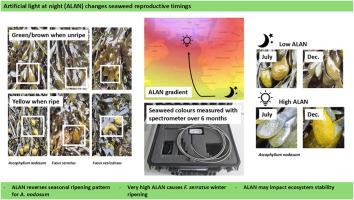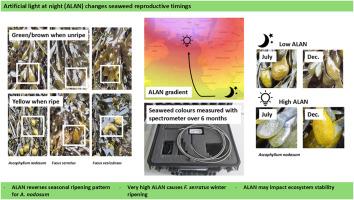Artificial light at night alters seaweed reproductive phenology
IF 7.3
2区 环境科学与生态学
Q1 ENVIRONMENTAL SCIENCES
引用次数: 0
Abstract
Artificial light at night (ALAN) is a growing, globally prevalent environmental stressor. It is known to disrupt biological processes across taxa and biomes, including reproductive phenology in terrestrial plants, but its potential to alter reproductive timings in marine macroalgae remains unexplored. We used reflectance spectrometry to quantitatively assess changes in receptacle ripeness of three fucoid macroalgae species at four field sites along an ALAN gradient in Plymouth Sound, UK over a six-month period. At sites with elevated ALAN (measured using Sky Quality Meters, range 16.15–18.76 mag arcsec−2, equivalent to 3.75 × 10−2–3.38 × 10−3 cd/m2), expected seasonal patterns of receptacle ripening in Ascophyllum nodosum were reversed, causing receptacles to continue ripening into the winter months as opposed to peaking during the summer. Fucus serratus also continued to ripen in winter when exposed to the highest ALAN levels (16.15 mag arcsec−2, 3.75 × 10−2 cd m−2). Our results provide some of the first evidence that ALAN disrupts reproductive timings in fucoid macroalgae. Given the critical role of fucoids in coastal ecosystems worldwide, ALAN should be recognised as a potential driver of ecological change in these species. Incorporating ALAN into conservation strategies is essential for protecting these foundational habitats.


夜间的人造光改变了海藻的繁殖物候
夜间人造光(ALAN)是一个日益增长的、全球普遍存在的环境压力源。已知它会破坏不同分类群和生物群系的生物过程,包括陆生植物的生殖物候,但其改变海洋大型藻类繁殖时间的潜力仍未被探索。我们使用反射光谱法定量评估了在英国普利茅斯海峡沿ALAN梯度的四个野外站点上三种岩藻类大型藻类的容器成熟度变化。在ALAN升高的地点(使用天空质量计测量,范围16.15-18.76 mag arcsec2,相当于3.75×10-2-3.38×10-3 cd/m2),葡萄花托成熟的预期季节模式被逆转,导致花托在冬季继续成熟,而不是在夏季达到峰值。当ALAN浓度最高(16.15 mag arcsec-2, 3.75×10-2 cd m-2)时,黑角藻在冬季也能继续成熟。我们的研究结果提供了一些第一个证据,证明ALAN破坏了岩藻类巨藻的繁殖时间。鉴于岩藻类在全球沿海生态系统中的关键作用,ALAN应该被认为是这些物种生态变化的潜在驱动因素。将ALAN纳入保护策略对于保护这些基础栖息地至关重要。
本文章由计算机程序翻译,如有差异,请以英文原文为准。
求助全文
约1分钟内获得全文
求助全文
来源期刊

Environmental Pollution
环境科学-环境科学
CiteScore
16.00
自引率
6.70%
发文量
2082
审稿时长
2.9 months
期刊介绍:
Environmental Pollution is an international peer-reviewed journal that publishes high-quality research papers and review articles covering all aspects of environmental pollution and its impacts on ecosystems and human health.
Subject areas include, but are not limited to:
• Sources and occurrences of pollutants that are clearly defined and measured in environmental compartments, food and food-related items, and human bodies;
• Interlinks between contaminant exposure and biological, ecological, and human health effects, including those of climate change;
• Contaminants of emerging concerns (including but not limited to antibiotic resistant microorganisms or genes, microplastics/nanoplastics, electronic wastes, light, and noise) and/or their biological, ecological, or human health effects;
• Laboratory and field studies on the remediation/mitigation of environmental pollution via new techniques and with clear links to biological, ecological, or human health effects;
• Modeling of pollution processes, patterns, or trends that is of clear environmental and/or human health interest;
• New techniques that measure and examine environmental occurrences, transport, behavior, and effects of pollutants within the environment or the laboratory, provided that they can be clearly used to address problems within regional or global environmental compartments.
 求助内容:
求助内容: 应助结果提醒方式:
应助结果提醒方式:


